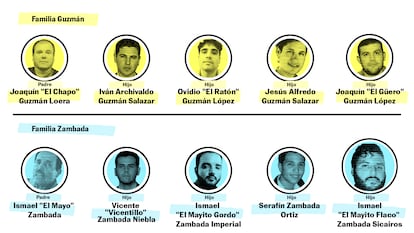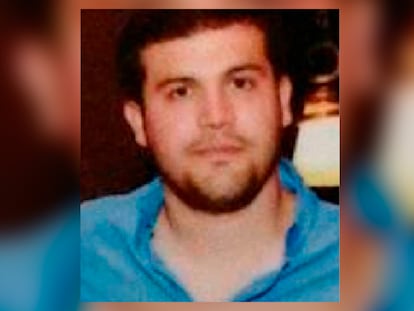The Sinaloa Cartel after ‘El Mayo’ Zambada: Mexico fears outbreak of violence after arrest of drug lord
The arrest of the co-founder of the powerful criminal organization in the US opens up several possible scenarios: wars of succession, changes in the criminal structure, and confrontation with the Jalisco New Generation Cartel
A pre-arranged surrender to the authorities, a deception, or kidnapping at the hands of his former associates. These are the three main hypotheses that have gained traction following the fall of Ismael “El Mayo” Zambada, one of the world’s most feared and powerful drug traffickers. Certainties about his mysterious arrest have faded in recent days and questions are also emerging about the consequences of his detention and its implications for the Sinaloa Cartel’s leadership “We all know that these are groups that have been involved in illicit activities for years — they are the most famous in the country, so to speak — and yet even though this is a delicate matter there has been no confrontation between them,” said Mexican President Andrés Manuel López Obrador last Friday. A dispute over succession, restructuring, and splits in the hierarchy of the criminal organization — as well the reaction of rivals such as the Jalisco New Generation Cartel (CJNG) — remain a latent possibility and have placed the population of the northwest of the country, where those loyal to El Mayo and Joaquín “El Chapo” Guzmán have their strongholds, on alert.
“What one would expect is that when the overall leader of one of the factions is taken down, the rest will try to take advantage,” says Laura Atuesta, a professor at the Mexican Center for Research and Teaching in Economics and coordinator of the Drug Policy Program. That is the central hypothesis that overhangs all analyses, although it is a scenario that seems not to have yet swung into motion. David Saucedo, a security analyst, forecasts three violent outcomes following Zambada’s detention: a war of succession between the faction led by El Mayo and Los Chapitos, the four heirs to El Chapo Guzmán; a dispute for the leadership limited to the cells linked to Zambada; or confrontation with the CJNG if the latter seeks to take advantage of the weakness of their enemies.
The arrests of Ovidio Guzmán — the first Chapito to fall into the custody of the U.S. authorities — in 2019 and 2023 also weigh in the equation. Both detentions were met by violent acts of retribution by the cartel and open confrontation with the authorities in Sinaloa, which led to episodes such as the so-called Culiacanazo in which Los Chapitos wreaked havoc on the city of Culiacán. There is also the precedent of the violent divorce between the Sinaloa Cartel and the Beltrán Leyva Cartel, which caused bloodshed at the beginning of the war against drugs during the six-year term of Felipe Calderón. “So far, in the states and municipalities of El Mayo’s empire, there have been no narco-blockades, attacks against the civilian population, or acts of narco-terrorism,” notes Saucedo.
Since Zambada was arrested on July 25 along with Joaquín Guzmán López, another of El Chapo’s sons, at a rural airport in New Mexico, some 400 soldiers have been deployed in Sinaloa, according to the weekly Riodoce. Other media have reported the presence of around 3,400 troops in the state. López Obrador confirmed that the preventive deployment has been reinforced, but did not provide a figure for the number of agents or soldiers sent to the region. This is one of the factors attributed to retaliation for El Mayo’s arrest not having materialized.
Another deterrent has been not wanting to show weakness in the face of the CJNG, which is still perceived as a common enemy of both the Los Mayos and Los Chapitos factions, notes former DEA agent Mike Vigil. “It could result in a bloodbath because there are so many who can take over the cartel,” he warns. The DEA has identified two other factions under the Sinaloa Cartel umbrella: the men who answer to Rafael Caro Quintero and those loyal to Aureliano “El Guano” Guzmán, El Chapo’s brother. The U.S. anti-narcotics force claimed months ago that tensions between the groups linked to Zambada and Los Chapitos had increased, an open secret fueled by the ambition of El Chapo’s sons, who took the lead following their father’s extradition in 2017.
Ovidio and Joaquín Guzmán are already in the hands of the U.S. justice system, but Vigil claims they were not as powerful as their two brothers, Iván Archivaldo and Jesús Alfredo Guzmán, who remain at large and have a reputation for being more ambitious and impulsive. Those personality traits have been put forward to argue that El Mayo did not suspect Joaquín Guzmán, his godson, when he allegedly set him up to board the plane that landed on U.S. soil. Zambada’s lawyer has spoken directly of a betrayal and kidnapping at the hands of El Chapo’s son. The debate over the theories surrounding El Mayo’s arrest is relevant because of its possible implications and the messages being sent to the cartel. “That’s why the U.S. and possibly Mexican governments don’t want to give many details,” says the former DEA agent.
Much more is known about Los Chapitos than about El Mayo’s sons. One widespread hypothesis is that Zambada had for years been mulling handing over control of his group to Vicente “El Vicentillo” Zambada Niebla, who was arrested in Mexico City in 2009 and extradited a year later to the United States, where he cooperated with authorities and was released after appearing as a key witness in the 2018 El Chapo trial. After Vicente Zambada left the criminal life, his father set his sights on Ismael Zambada Sicairos, alias “Mayito Flaco,” and Ismael Zambada Imperial, “Mayito Gordo,” as possible successors.

U.S. court records detail that El Mayo spent years grooming his sons for a succession. Mayito Gordo was arrested in 2014 in Culiacán, extradited in 2019, and sentenced to nine years in California in 2021 after pleading guilty to several drug trafficking charges. Zambada Imperial was released in July 2022 and deported to Mexico, apparently because his sentence took into account the years he had already served in his native country.
Mayito Flaco is on the DEA’s list of most wanted fugitives and has been under U.S. scrutiny for years, but remains active. “Unlike Los Chapitos, El Mayo has tried to ensure that his children do not have a life that resembles that of influencers, that they keep a low profile, that they stay away from scandals,” says Saucedo. “He trained them from the ground up; they were originally drug dealers and worked their way up in the organization based on their merits and, of course, the support of their father.” Serafín Zambada Ortiz, the youngest, seems to be one rung below his siblings.
Mexico’s major cartels base their leadership structures on family relationships; in El Mayo’s case this includes his son-in-law Juan Carlos Félix, who is married to Teresita Zambada. There is also talk that his nephews may step forward. José Luis González Meza, who for years has presented himself as the Guzmán family’s lawyer, came out this week to quell rumors of an alleged betrayal and stated that El Mayo’s was a voluntary surrender. In a brief statement, he assured that the relationship between both families has been “impeccable, to the extent that there are marriages” between them and members are often appointed godparents to others’ children. The flip side is what El Mayo’s men might think and how they might react to the possibility of their boss turning himself in and potentially cooperating with the U.S. authorities.
Los Chapitos have grown up in their father’s shadow, as have Los Mayitos. Their leadership styles and success have often been scrutinized in comparison to the old days. Vigil, for example, questions whether Zambada’s heirs can maintain control of the organization and fill those shoes. “Most likely Mayito Flaco will take over, he is the one who was the strongest,” he says.
The hypothesis has grown that El Mayo, whose health is reported to be deteriorating, planned a succession that will have cushioned the blow of his departure from the operational structure. “If this had happened a year ago, I would say it would have meant a drastic change in the geopolitics of drug trafficking in Mexico, but around that time Zambada began to delegate several tasks to his sons. I think he had considered the possibility of retiring for his health or giving himself up,” notes Saucedo.
The consulting firm Lantia, owned by analyst Eduardo Guerrero, states that Los Mayitos and Los Chapitos share a presence in Sinaloa, Durango, Sonora and Baja California. Zambada’s people are spread out separately in Zacatecas, Jalisco, Guanajuato, Querétaro and Michoacán, while El Chapo’s sons have Mexico City and Quintana Roo as other areas of influence, according to this study, considered one of the most accurate.
“El Mayo’s criminal governance is much stronger than that of Los Chapitos,” Atuesta points out. “Durango is a striking example, where they have a state of peace and obedience that, as I understand it, is attributed to Zambada.” The specialist has mapped the territorial evolution of criminal groups for more than 15 years, from the early years of the drug war to 2022, and says that attention should be paid to transitional regions such as Zacatecas.
“Zacatecas became this war zone to protect the golden triangle,” Atuesta says. The northwest corridor — where fractures have already been witnessed (as in the case of Sonora) and fights have broken out over routes to border cities — are areas of interest due to an internal struggle within the Sinaloa Cartel, Vigil adds. If Lantia’s diagnosis is confirmed, other hotspots could emerge in Jalisco and El Bajio, territories in dispute with the CJNG.
Atuesta also points out that it is necessary to take into account the reactions of the armed wings of the cartel, as in the case of Gente Nueva, which is linked to the Sinaloa structure in Chihuahua. The case in Texas, where El Mayo is being held, delves into the relationships Zambada and El Chapo forged to support those associates with weapons, drugs and money to fight the Juárez Cartel. Atuesta fears that history could repeat itself as it did with the Gulf Cartel, which was replaced by Los Zetas, an organization comprised of its former hitmen. Faced with an apparent lack of leadership and the notion of internal disorder, another possibility is that “these groups will decide to fragment or split up, and that will generate more violence.”
Saucedo lists five warning factors that could indicate changes and rearrangements in Mexico’s criminal geography following El Mayo’s arrest. The first is acts of narcoterrorism against the civilian population in visible places, where often attacks are designed to send messages, such as shopping malls, restaurants, or public roads. The second are attacks on high-level police chiefs, because when a cartel invades a territory, it attempts to bribe agents and officials and kills them when they do not yield to pressure. The third are assassinations of journalists who cover drug trafficking or who lend themselves to disseminate narratives favorable to the various criminal groups. The fourth is the movement of security forces and the deployment of troops to reinforce certain areas. Finally, the actions taken by U.S. agencies such as the DEA in Mexico: “When DEA agents arrive, everyone knows about it,” he notes.
A possible response from the cartel also has repercussions in the political and diplomatic field, with a change of government in Mexico and the presidential election in the United States coming up in November. The paradox is that the shared notion of many specialists is Zambada’s fall will have no impact on drug flows to the United States. The head has been removed, but the cartel’s structures remain in place.
On the other hand, El Mayo’s arrest could alter security on Mexican territory, a country that has paid for the crusade against drugs with hundreds of thousands of deaths. On the other side of the border, tens of thousands die each year from drug overdoses, in a phenomenon often reduced to the forces of supply and demand for narcotics. Just this week, López Obrador called for restraint on the part of the criminal groups involved. “I urge everyone to act responsibly,” he said.
Sign up for our weekly newsletter to get more English-language news coverage from EL PAÍS USA Edition
Tu suscripción se está usando en otro dispositivo
¿Quieres añadir otro usuario a tu suscripción?
Si continúas leyendo en este dispositivo, no se podrá leer en el otro.
FlechaTu suscripción se está usando en otro dispositivo y solo puedes acceder a EL PAÍS desde un dispositivo a la vez.
Si quieres compartir tu cuenta, cambia tu suscripción a la modalidad Premium, así podrás añadir otro usuario. Cada uno accederá con su propia cuenta de email, lo que os permitirá personalizar vuestra experiencia en EL PAÍS.
¿Tienes una suscripción de empresa? Accede aquí para contratar más cuentas.
En el caso de no saber quién está usando tu cuenta, te recomendamos cambiar tu contraseña aquí.
Si decides continuar compartiendo tu cuenta, este mensaje se mostrará en tu dispositivo y en el de la otra persona que está usando tu cuenta de forma indefinida, afectando a tu experiencia de lectura. Puedes consultar aquí los términos y condiciones de la suscripción digital.
More information
Archived In
Últimas noticias
Welcome to the post-religion era: The idea of Christianity as the absolute truth has become obsolete
‘I thought you would like it’: The risky sexual practice popularized by TV shows and TikTok
The digitalization of tourism: ‘They promise experiences and gave us the worst possible one’
Mexican peso defies uncertainty with forecasts of a new period of stability in 2026
Most viewed
- Sinaloa Cartel war is taking its toll on Los Chapitos
- Reinhard Genzel, Nobel laureate in physics: ‘One-minute videos will never give you the truth’
- Oona Chaplin: ‘I told James Cameron that I was living in a treehouse and starting a permaculture project with a friend’
- Why the price of coffee has skyrocketed: from Brazilian plantations to specialty coffee houses
- Silver prices are going crazy: This is what’s fueling the rally











































